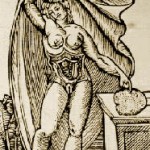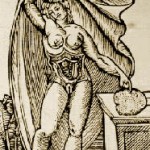By Helen King W&M Contributor
Last month, in a much-repeated comment, Todd Akin recently claimed that ‘if it’s a legitimate rape, the female body has ways to try to shut that whole thing down’. Not surprisingly, he has been ridiculed for the lack of knowledge of biology that this comment betrays. It didn’t take long, though, before history started to come into the discussion.
On 20 August the Guardian newspaper published an article on how the belief that a woman has to enjoy sex in order to conceive went back to medieval notions of the body. Some ancient authorities, used in medieval medicine, claimed that both men and women make ‘seed’ and both have to ejaculate it if conception is to take place. So, if the woman conceives, she must have ejaculated; and if she ejaculated, she must have had an orgasm; and if she had an orgasm, she must have enjoyed it. However, this was only one option in ancient and medieval medicine. Other authorities thought that only men made seed, so that women’s pleasure, or lack of it, was pretty irrelevant. And, as my fellow Classics professor Edith Hall pointed out in her blog, classical myth and drama flourished on stories where victims of rape became pregnant – Romulus and Remus would not have existed (insofar as mythical heroes ‘exist’) without the rape of their mother by a god!
But, actually, I don’t think that was quite what Akin was saying here. The idea that ‘the female body has ways’ reminds me of another ancient Greek idea, one found in one particular Hippocratic treatise called ‘On Fleshes’, namely that women can eject the male seed in the first few days of pregnancy.
The Hippocratic corpus is more like a library – it’s not one person’s work. Some texts included in it present women as supplying the raw material for a baby – blood – while men’s seed activates this and shapes it. They argue that a woman’s body could sometimes make a shapeless mass called a ‘mole’ (from the Greek word for ‘mill-stone’, implying something heavy and immobile). This would happen if she had a lot of blood, and the man’s seed was only ‘scanty and sickly’. If nothing moved after 3 months (the time taken for a male foetus to become active in the womb), or 4 (the time for a female foetus to start to move), ‘when this time has passed and there is no movement, it is obviously a mole’. They also thought that a woman knew when she had conceived because she would observe that the man’s seed had not fallen out, and she would actually feel the mouth of her womb closing up to keep the man’s seed inside her. Lying down with her legs crossed after sex would make it more likely that the seed stayed in.
The man who wrote ‘On Fleshes’ names his sources for the information he gives about how babies are made in the womb: the hetairai demosiai or public prostitutes. They know, he says, when they have conceived, and they destroy the child. There is nothing in the text to explain just how they do it. In cases where a married couple couldn’t conceive, ‘women have ways’ may have been a cultural move to say, it’s not men’s fault; their seed is up to the job, but those sneaky women know how to stop it working.
However, Akin’s remark separates ‘the female body’ from the conscious will of the woman. So another Hippocratic idea that strikes me as relevant is the ‘wandering womb’. Here too we find ‘the female body’ acting on its own. The womb moves from mechanical principles; if it gets too dry, it may start moving up towards the moisture of another organ, the liver. The Hippocratic authors may have been contemporary with Plato, who famously wrote in the Timaeus that both men and women have an ‘out-of-control’ organ – penis, or womb. Some contemporary debates about rape suggest that men can’t help it, if presented with an attractive woman. But ancient philosophy also proposed that the mind should be able to control the body. Perhaps the idea that ‘the female body has ways’ suggests that women are just too much ‘of the flesh’ to exert that control?


